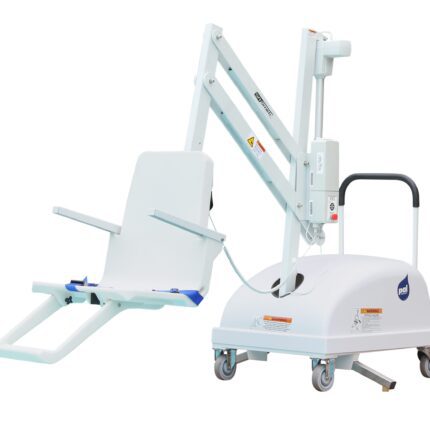Mobile pool lifts
Mobile pool lifts have been designed to make access to swimming pools and spas easier for people with reduced mobility or disabilities. Unlike fixed pool lifts, they do not need to be anchored in the pool deck before use. They are generally mounted on castors, which means they can be moved around a pool and serve several pools in the same establishment. Their use is aimed at promoting inclusion and enabling everyone to enjoy the benefits of swimming and hydrotherapy.
Operating procedures for mobile pool lifts
Mobile pool lifts operate on two principles: battery-powered or manual with a winch.
Electric lifts are often preferred for their ease of use. They are powered by a rechargeable battery which drives a jack that raises and lowers the lift seat. This movement is generally fluid and stable, allowing the user to feel secure. What sets the PandaPool lift apart from other battery-powered electric lifts is its motorised movement, which means it can be moved with a minimum of effort. The other lifts are moved by arm power.
Manual lifts, on the other hand, require a little more work. They are fitted with a winch that must be operated manually to raise and lower the lift seat. What’s more, you have to use your arms to move them around the pool. However, these models have the advantage of being a little more economical and not being subject to the vagaries of electric batteries to operate.
Self-contained pool lifts
Mobile pool lifts such as the PAL and PelicanPool can be used completely autonomously once positioned at the edge of the pool. They are equipped with a motor that rotates the seat. So with a simple remote control, the user can turn the seat of the lift and get in and out of the water without any external assistance. This offers users a considerable degree of independence.
ELE-R-E lifts use a rail to lower the lift seat into the pool. The motor unit is positioned at the edge of the pool and connected to the rail that runs along the bottom of the pool to ensure stability. The lift, which does not require anchoring, is easy to install and remove. The lowering movement of the seat is stable and safe.
Other mobile pool lifts require the help of an assistant to operate. These models are usually mounted on castors to make them easier to move around. After helping the user onto the seat of the lift, the assistant positions the user at the edge of the pool and operates the control or winch to lower and raise the seat.
Weights and seats for mobile pool lifts
The weight of mobile pool lifts is an important factor to consider. These devices are generally weighted to ensure stability during use. What’s more, the wheel-mounted lifts that allow you to descend independently are often the heaviest, to ensure optimum balance when moving the seat.
The riser seats are all rigid to provide optimum support for the user. Most of them come with the option of 4 or 5-point seatbelts and a headrest to support users with trunk support difficulties when travelling.
Handicap Accès offers the widest range of pool lifts and mobile lifts on the market. Their price depends on the many criteria mentioned above: maximum weight, manual or electric mechanism, autonomous or assisted use, etc. Read our advice sheet comparing mobile pool lifts to help you choose the right mobile pool lift for your needs.





